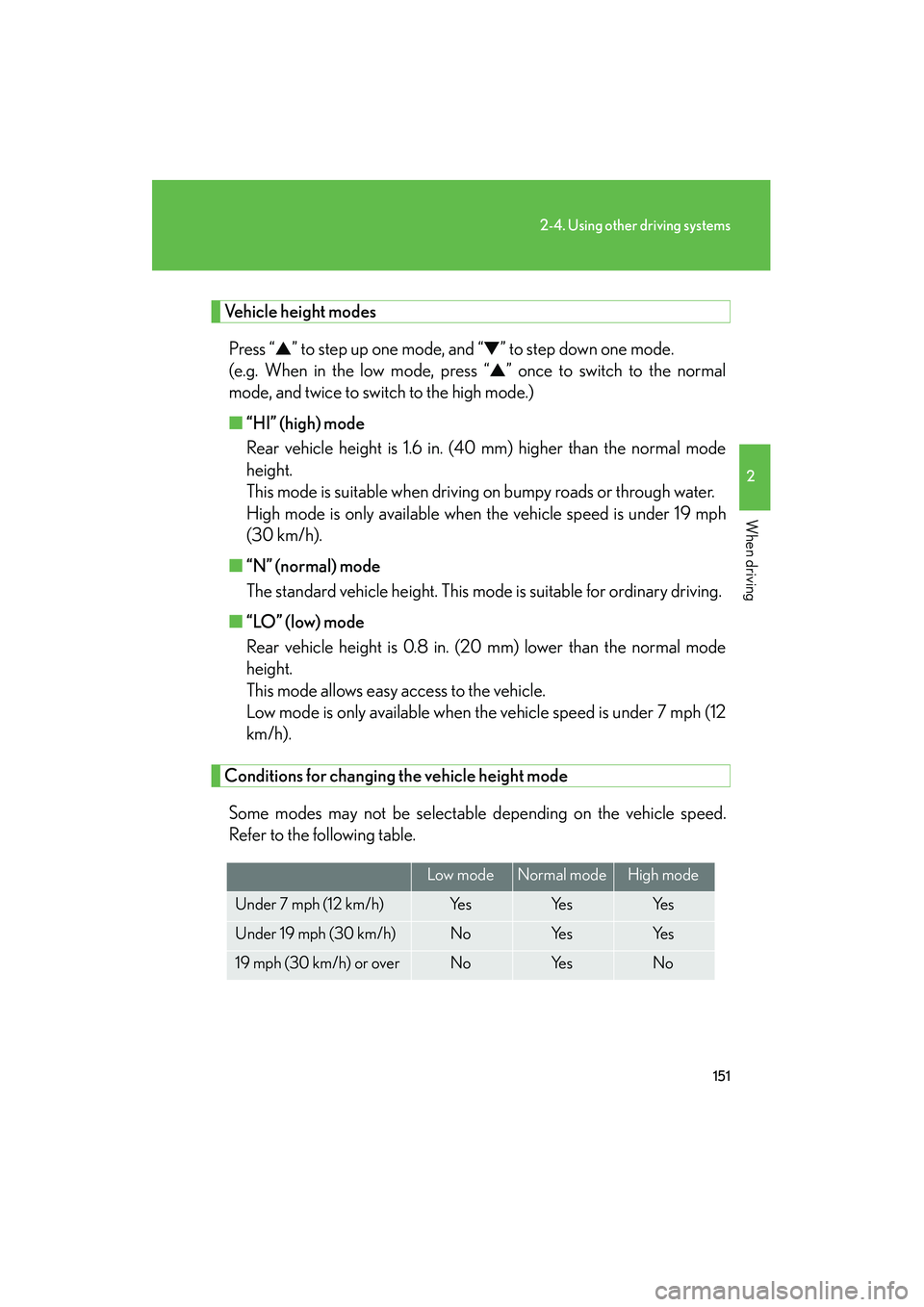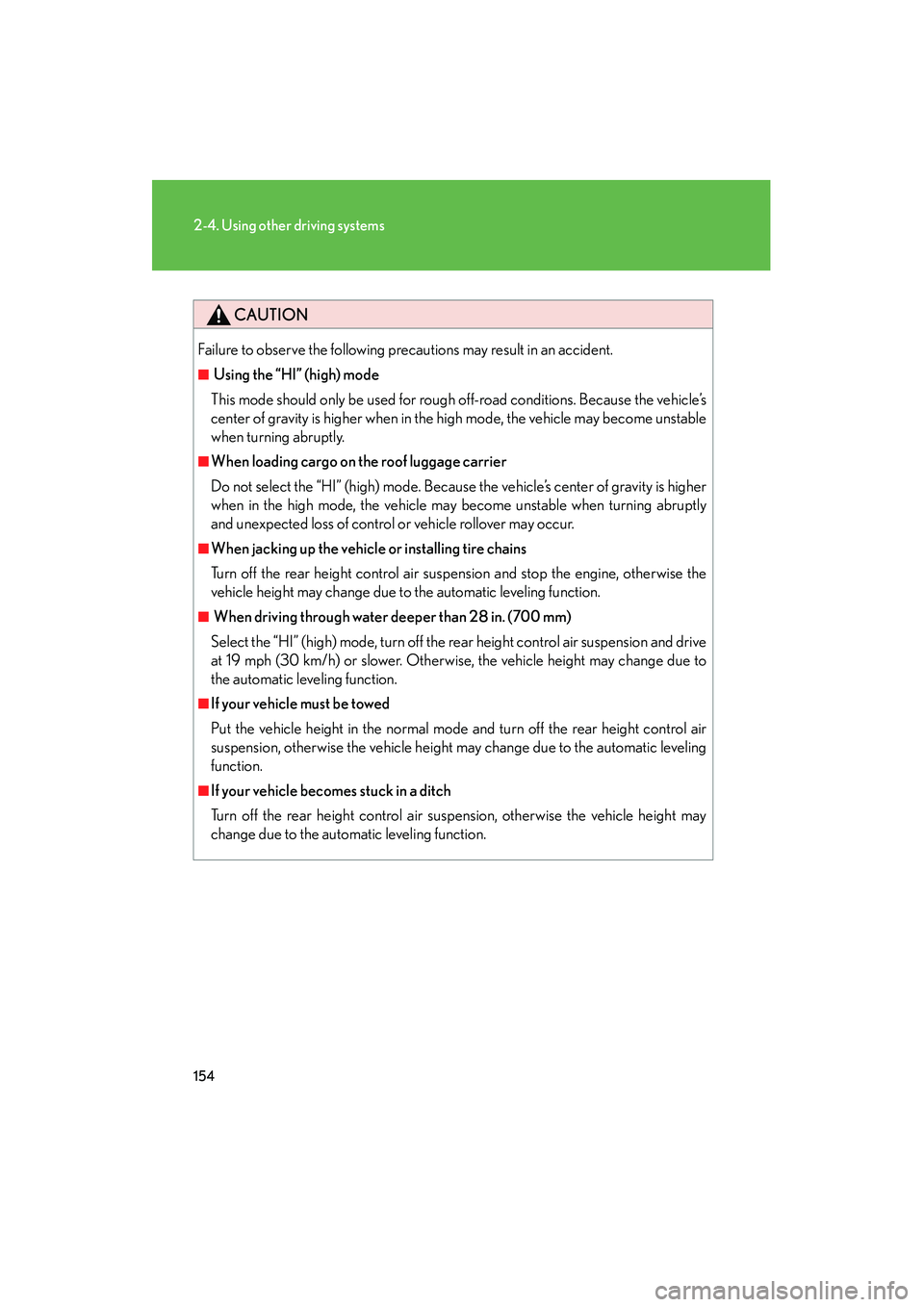Lexus GX470 2008 Owner's Manual
Manufacturer: LEXUS, Model Year: 2008, Model line: GX470, Model: Lexus GX470 2008Pages: 458, PDF Size: 5.93 MB
Page 151 of 458

150
2-4. Using other driving systems
■Height control indicator lights
Height control mode indica-
tors
Height control “OFF” indica-
tor
Page 152 of 458

151
2-4. Using other driving systems
2
When driving
Vehicle height modesPress “ ▲” to step up one mode, and “ ▼” to step down one mode.
(e.g. When in the low mode, press “ ▲” once to switch to the normal
mode, and twice to switch to the high mode.)
■ “HI” (high) mode
Rear vehicle height is 1.6 in. (40 mm) higher than the normal mode
height.
This mode is suitable when driving on bumpy roads or through water.
High mode is only available when the vehicle speed is under 19 mph
(30 km/h).
■ “N” (normal) mode
The standard vehicle height. This mode is suitable for ordinary driving.
■ “LO” (low) mode
Rear vehicle height is 0.8 in. (2 0 mm) lower than the normal mode
height.
This mode allows easy access to the vehicle.
Low mode is only available when the vehicle speed is under 7 mph (12
km/h).
Conditions for changing the vehicle height mode
Some modes may not be selectable depending on the vehicle speed.
Refer to the following table.
Low modeNormal modeHigh mode
Under 7 mph (12 km/h)Ye sYe sYe s
Under 19 mph (30 km/h)NoYe sYe s
19 mph (30 km/h) or overNoYe sNo
Page 153 of 458

152
2-4. Using other driving systems
Height control indicator lightsIf you change the vehicle height mode, the indicator lights change as fol-
lows: • The current mode indicator light will turn off, and the selected modeindicator light will begin flashing.
• Once the change in vehicle height is complete, the selected mode indicator light will change from flashing to continuously lit.
■Operating conditions
●The engine must be running.
●Vehicle speed must be within the acceptable range for the selected mode.
■Automatic change in vehicle height
If the vehicle speed exceeds 19 mph (30 km/h) when in the high mode, or 7 mph
(12 km/h) when in the low mode, normal mode is automatically selected.
■Turning off the rear height control air suspension
●The system will remain off until the switch is pushed again, even if the engine
switch is turned off.
●Even if the rear height control air suspension is turned off, the system automati-
cally selects the normal mode if the vehicle’s speed exceeds 19 mph (30 km/h).
■Automatic leveling function
The vehicle is adjusted to a fixed height for each mode, regardless of the number of
occupants and the luggage load.
Page 154 of 458

153
2-4. Using other driving systems
2
When driving
■If the vehicle height does not change
If the area around the rear suspension is coated with ice, or the undercarriage has
come into contact with the road surface, the rear height control suspension will not
operate. In this case, the indicator lights will change as follows:
●The current mode indicator light will turn off, and the target mode indicator light
will begin flashing.
●The target mode indicator light will turn off, and the original mode indicator light
will be lit once more. (The vehicle height does not change.)
If the rear height control air suspension cannot be operated even after removing
the ice or progressing to a smooth driving surface, turn off and restart the engine.
■ Parking and stopping tips
●If you immediately stop the engine after off-road driving, or park the vehicle for
a long time, the vehicle height may gradually lower. When parking, make sure
there is nothing under the vehicle that may come in contact with the underbody.
The vehicle will return to the set height when the engine is started.
●The vehicle height may change as the temperature changes when the engine is
stopped. The vehicle will return to the set height when the engine is started.
■When lowering the vehicle
Even if the engine is stopped while the vehicle height is being lowered, operation
will continue for up to 25 seconds. If any of the side doors or the back door is
opened within this 25 seconds, operation will continue for a further 15 seconds.
■ Rear height control failure warning
●If a malfunction occurs in the rear height control air suspension, normal mode is
automatically selected.
The height control “OFF” indicator will blink, and the vehicle height control can-
not be activated until the malfunction is corrected. Have the vehicle checked at
your Lexus dealer as soon as possible.
●If the height control “OFF” indicator lig ht does not come on when the engine
switch is turned to the “ON” position, there is a malfunction in the rear height
control air suspension. You can continue normal driving, however have the vehi-
cle checked by your Lexus dealer as soon as possible.
Page 155 of 458

154
2-4. Using other driving systems
CAUTION
Failure to observe the following precautions may result in an accident.
■ Using the “HI” (high) mode
This mode should only be used for rough off-road conditions. Because the vehicle’s
center of gravity is higher when in the high mode, the vehicle may become unstable
when turning abruptly.
■When loading cargo on the roof luggage carrier
Do not select the “HI” (high) mode. Because the vehicle’s center of gravity is higher
when in the high mode, the vehicle may become unstable when turning abruptly
and unexpected loss of control or vehicle rollover may occur.
■When jacking up the vehicle or installing tire chains
Turn off the rear height control air suspension and stop the engine, otherwise the
vehicle height may change due to the automatic leveling function.
■ When driving through water deeper than 28 in. (700 mm)
Select the “HI” (high) mode, turn off the rear height control air suspension and drive
at 19 mph (30 km/h) or slower. Otherwise, the vehicle height may change due to
the automatic leveling function.
■If your vehicle must be towed
Put the vehicle height in the normal mode and turn off the rear height control air
suspension, otherwise the vehicle height may change due to the automatic leveling
function.
■If your vehicle becomes stuck in a ditch
Turn off the rear height control air suspension, otherwise the vehicle height may
change due to the automatic leveling function.
Page 156 of 458

155
2-4. Using other driving systems
2
When driving
NOTICE
■To avoid damage to the vehicle
●If in the low mode, the vehicle automatically shifts to the normal mode (vehicle
height is raised) when the engine is started. Take care when overhead height is
limited.
●After unloading, the vehicle height may be slightly higher than normal. Take care
when overhead height is limited.
●Before lowering the vehicle height, check that no-one is under the vehicle and
the area is free of obstructions. Also check that the underbody of the vehicle will
not touch the ground.
●Do not select the low mode when driving on bumpy roads, as the underbody of
the vehicle may contact the road surface.
■ Avoid rapid changes to the vehicle height when the vehicle is heavily loaded
As the compressor may overheat, causing the vehicle height adjustment operation
to stop.
Page 157 of 458

156
2-4. Using other driving systems
Electronic modulated suspension
■Driving mode
●Mode is suitable for ordinary driving.
●Mode or is suitable for heavy load or driving on a unpaved road.
●With the four-wheel drive control lever at “L”, the damping effect suitable for off-
road driving will be provided.
The electronic modulated suspension controls the suspension according to
the road and driving conditions. Selected driving mode allows for good
riding comfort and stability.
For driving on a bumpy road
For ordinary driving such as
in the city traffic
For moderate high speed
driving
For sporty type driving such
as on winding mountain
roads and high speed driving.
Soft Hard
Page 158 of 458

157
2-4. Using other driving systems
2
When driving
DAC (Downhill Assist Control system)
The DAC helps to prevent excessive speed on steep downhill slopes.
The system will operate when the vehicle is traveling under 15 mph
(25 km/h) and the four wheel drive control lever is in the “L” position.
■System operation
Press the “DAC” switch. The
indicator will come on, and the
system will operate.
When the system is in operation,
the slip indicator light will flash,
and the stop lights/high
mounted stop lights will be lit.
■Turning off the system
Press the “DAC” switch while the system is in operation. The indica-
tor will flash as the system gradually ceases operation, and will turn
off when the system is fully off.
Press the “DAC” switch while the indicator is flashing to start the
system again.
Page 159 of 458

158
2-4. Using other driving systems
■Operating tips
The system will operate when the shift lever is in a position other than “P”, however
to make effective use of the system it is recommended that the shift lever be shifted
to “2” or “L”.
■If the four wheel drive control lever is in “H”
The system will not operate.
■If the brake system overheats
The system will cease operation and a buzzer will sound to alert the driver.
Stop the vehicle in a safe place. (There is no problem with continuing normal driv-
ing.)
■System malfunction
●The “DAC” indicator does not come on when the engine switch is turned to the
“ON” position.
●The “DAC” indicator does not come on when the “DAC” switch is pressed.
In the above cases have your vehicle checked by your Lexus dealer.
CAUTION
■The system may not operate on the following surfaces, which may lead to an acci-
dent causing death or serious injury.
●Slippery surfaces such as wet or muddy roads
●Icy surfaces
●Unpaved roads
Page 160 of 458

159
2-4. Using other driving systems
2
When driving
Driving assist systems
To help enhance driving safety and performance, the following systems
operate automatically in response to various driving situations. Be aware,
however, that these systems are supplementary and should not be relied
upon too heavily when operating the vehicle.
■ ABS (Anti-lock Brake System)
Helps to prevent wheel lock when the brakes are applied suddenly, or if
the brakes are applied while driving on a slippery road surface.
■Brake Assist
Generates an increased level of braking force after the brake pedal is
depressed, when the system detects a panic stop situation.
■VSC (Vehicle Stability Control)
Helps the driver to control skidding when swerving suddenly or turning on
slippery road surfaces.
■Active traction control
Maintains drive power and prevents the 4 wheels from spinning when
starting the vehicle or accelerating on slippery roads.
■Hill-start assist control
Helps prevent the vehicle from rolling backwards when starting on an
incline or slippery slope. It operates for approximately 5 seconds at maxi-
mum.
■Limited Slip Differential
Transfers drive power to the rear tires when front tires spin, and vice versa,
in order to improve traction.
■Kinetic Dynamic Suspension System (if equipped)
Kinetic Dynamic Suspension System helps to significantly enhance han-
dling response by reducing roll stiffness of the suspension stabilizer bars
through means of a hydraulic control system.